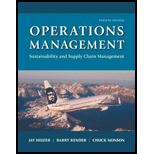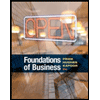
Operations Management: Sustainability and Supply Chain Management (12th Edition)
12th Edition
ISBN: 9780134130422
Author: Jay Heizer, Barry Render, Chuck Munson
Publisher: PEARSON
expand_more
expand_more
format_list_bulleted
Concept explainers
Question
Chapter 6, Problem 1DQ
Summary Introduction
To determine: The way quality can reduce the cost.
Introduction:
Quality is a state of performance, and the excellence of a product or service differentiates it from the competitors’ products.
Expert Solution & Answer
Explanation of Solution
Determine the way quality can reduce the cost:
Improving quality leads to reduced costs in the following ways:
- Higher quality means less rejection, scrap, or rework. Therefore, there are savings with improved quality in terms of material costs and labor costs, besides better utilization of machinery and other capital assets.
- Poor quality also leads to customer dissatisfaction, customer complaints, and warranty costs, besides the impairment of the company’s brand image. All these add to the costs in significant ways. Improving quality will save such costs.
- Higher quality improves the company’s image in the market, contributing to the increase in the market share. It becomes easier to sell and therefore marketing costs such as advertising, sales promotion, discounts, and so on can be reduced.
- Higher quality and consequently increased market share also increase the production volumes, resulting in scale economies. Consequently, the portion of fixed costs in the unit cost comes down significantly.
- The good quality image also helps in not only attracting the talented people in the organization, but also in retaining them. Recruitment costs would come down, besides salary costs. Talented employees would be proud that they are on the payrolls of a quality conscious organization.
- Improved quality also enhances the company’s image with the investors, financial institutions, and so on, resulting in lower costs of raising finance.
Want to see more full solutions like this?
Subscribe now to access step-by-step solutions to millions of textbook problems written by subject matter experts!
Students have asked these similar questions
Durban woman, Nombulelo Mkumla, took to social media last week to share how she discovered the rodent.In a lengthy Facebook post, she said she purchased the loaf of bread from a local shop after work on August 27.For the next days, Mkumla proceeded to use slices of bread from the load to make toast."Then, on the morning of August 31, I took the bread out of the fridge to make toast and noticed something disgusting andscary. I took a picture and sent it to my friends, and one of them said, 'Yi mpuku leyo tshomi' [That's a rat friend]“."I was in denial and suggested it might be something else, but the rat scenario made sense - it's possible the rat got into thebread at the factory, and no one noticed," Mkumla said.She went back to the shop she'd bought the bread from and was told to lay a complaint directly with the supplier.She sent an email with a video and photographs of the bread.Mkumla said she was later contacted by a man from Sasko who apologised for the incident.According to…
PepsiCo South Africa says the incident where a woman discovered part of a rodent in her loaf of bread, is anisolated occurrence.Durban woman, Nombulelo Mkumla, took to social media last week to share how she discovered the rodent.In a lengthy Facebook post, she said she purchased the loaf of bread from a local shop after work on August 27.For the next days, Mkumla proceeded to use slices of bread from the load to make toast."Then, on the morning of August 31, I took the bread out of the fridge to make toast and noticed something disgusting andscary. I took a picture and sent it to my friends, and one of them said, 'Yi mpuku leyo tshomi' [That's a rat friend]“."I was in denial and suggested it might be something else, but the rat scenario made sense - it's possible the rat got into thebread at the factory, and no one noticed," Mkumla said.She went back to the shop she'd bought the bread from and was told to lay a complaint directly with the supplier.She sent an email with a video and…
PepsiCo South Africa says the incident where a woman discovered part of a rodent in her loaf of bread, is anisolated occurrence.Durban woman, Nombulelo Mkumla, took to social media last week to share how she discovered the rodent.In a lengthy Facebook post, she said she purchased the loaf of bread from a local shop after work on August 27.For the next days, Mkumla proceeded to use slices of bread from the load to make toast."Then, on the morning of August 31, I took the bread out of the fridge to make toast and noticed something disgusting andscary. I took a picture and sent it to my friends, and one of them said, 'Yi mpuku leyo tshomi' [That's a rat friend]“."I was in denial and suggested it might be something else, but the rat scenario made sense - it's possible the rat got into thebread at the factory, and no one noticed," Mkumla said.She went back to the shop she'd bought the bread from and was told to lay a complaint directly with the supplier.She sent an email with a video and…
Chapter 6 Solutions
Operations Management: Sustainability and Supply Chain Management (12th Edition)
Ch. 6.S - Prob. 1DQCh. 6.S - Define in statistical control.Ch. 6.S - Prob. 3DQCh. 6.S - Prob. 4DQCh. 6.S - Prob. 5DQCh. 6.S - Prob. 6DQCh. 6.S - Prob. 7DQCh. 6.S - Prob. 8DQCh. 6.S - Prob. 9DQCh. 6.S - Prob. 10DQ
Ch. 6.S - Prob. 11DQCh. 6.S - Prob. 12DQCh. 6.S - Prob. 13DQCh. 6.S - Prob. 14DQCh. 6.S - Prob. 15DQCh. 6.S - Prob. 16DQCh. 6.S - Prob. 17DQCh. 6.S - What does the formula L = D2C mean?Ch. 6.S - Prob. 19DQCh. 6.S - An avant-garde clothing manufacturer runs a series...Ch. 6.S - Prob. 2PCh. 6.S - Prob. 3PCh. 6.S - Prob. 4PCh. 6.S - Prob. 5PCh. 6.S - Develop a flowchart [as in Figure 6.6 (e) and...Ch. 6.S - Prob. 7PCh. 6.S - Prob. 8PCh. 6.S - Prob. 9PCh. 6.S - Prob. 10PCh. 6.S - Prob. 11PCh. 6.S - Prob. 12PCh. 6.S - Prob. 13PCh. 6.S - Prob. 14PCh. 6.S - Prob. 15PCh. 6.S - Prob. 16PCh. 6.S - Prob. 17PCh. 6.S - Prob. 18PCh. 6.S - Prob. 19PCh. 6.S - Prob. 20PCh. 6.S - Prob. 21PCh. 6.S - Prob. 22PCh. 6.S - Prob. 23PCh. 6.S - Prob. 24PCh. 6.S - Prob. 25PCh. 6.S - Prob. 40PCh. 6.S - Prob. 41PCh. 6.S - Prob. 42PCh. 6.S - Prob. 43PCh. 6.S - Prob. 44PCh. 6.S - Prob. 45PCh. 6.S - Prob. 51PCh. 6.S - Prob. 52PCh. 6.S - Prob. 26PCh. 6.S - Prob. 27PCh. 6.S - Prob. 53PCh. 6.S - Prob. 54PCh. 6.S - Prob. 55PCh. 6.S - Prob. 1CSCh. 6.S - Prob. 2CSCh. 6.S - Prob. 1.1VCCh. 6.S - Prob. 1.2VCCh. 6.S - Prob. 1.3VCCh. 6.S - Prob. 2.1VCCh. 6.S - Prob. 2.2VCCh. 6.S - Prob. 2.3VCCh. 6.S - Prob. 2.4VCCh. 6 - Prob. 1DQCh. 6 - Prob. 2DQCh. 6 - Prob. 3DQCh. 6 - Prob. 4DQCh. 6 - Prob. 5DQCh. 6 - Prob. 6DQCh. 6 - Prob. 7DQCh. 6 - Prob. 8DQCh. 6 - Prob. 9DQCh. 6 - Prob. 10DQCh. 6 - Prob. 11DQCh. 6 - Prob. 12DQCh. 6 - Prob. 13DQCh. 6 - Prob. 14DQCh. 6 - Prob. 15DQCh. 6 - Prob. 16DQCh. 6 - Prob. 17DQCh. 6 - Prob. 18DQCh. 6 - An avant-garde clothing manufacturer runs a series...Ch. 6 - Prob. 2PCh. 6 - Prob. 3PCh. 6 - Prob. 4PCh. 6 - Kathleen McFaddens restaurant in Boston has...Ch. 6 - Develop a flowchart [as in Figure 6.6 (e) and...Ch. 6 - Prob. 7PCh. 6 - Prob. 8PCh. 6 - Prob. 9PCh. 6 - Prob. 10PCh. 6 - Prob. 11PCh. 6 - Prob. 12PCh. 6 - Prob. 13PCh. 6 - Prob. 14PCh. 6 - Prob. 15PCh. 6 - Prob. 16PCh. 6 - Prob. 17PCh. 6 - Prob. 1CSCh. 6 - How could the survey have been more useful?Ch. 6 - Prob. 3CSCh. 6 - Prob. 1.1VCCh. 6 - Prob. 1.2VCCh. 6 - Prob. 1.3VCCh. 6 - Prob. 1.4VCCh. 6 - Prob. 2.1VCCh. 6 - Prob. 2.2VCCh. 6 - Prob. 2.3VCCh. 6 - Prob. 2.4VCCh. 6 - Prob. 2.5VC
Knowledge Booster
Learn more about
Need a deep-dive on the concept behind this application? Look no further. Learn more about this topic, operations-management and related others by exploring similar questions and additional content below.Similar questions
- The deaths are included in the discharges; this includes deaths occurring in less than 48 hours and postoperative deaths. Rehabilitation had 362 discharges, 22 deaths, 1<48 hours, 0 Postoperative. what is the gross death rate for the rehabilitation service?arrow_forwardA copy machine is available 24 hours a day. On a typical day, the machine produces 100 jobs. Each job takes about 3 minutes on the machine, 2 minutes of which is processing time and 1 minute is setup time (logging in, defining the job). About 20 percent of the jobs need to be reworked, in which case the setup time and the processing time have to be repeated. The remainder of the time, the equipment is idle. What is the OEE of the equipment?arrow_forwardHow do you think we can keep updating Toyota's ideas as new technologies come out and what customers want keeps changing?arrow_forward
- Given how TPS has helped change things in so many fields, do you think there are parts of it that might be hard to use in areas that aren’t about making things, like in healthcare or services? If so, why do you think that might be?arrow_forwardDo you feel there is anything positive about rework?arrow_forwardDo you think technology can achieve faster setup times? How would it be implemented in the hospital workforce?arrow_forward
- In your experience or opinion, do you think process changes like organizing workspaces make a bigger difference, or is investing in technology usually the better solution for faster setups?arrow_forwardHave you seen rework done in your business, and what was done to prevent that from occurring again?arrow_forwardResearch a company different than case studies examined and search the internet and find an example of a business that had to rework a process. How was the organization affected to rework a process in order to restore a good flow unit? Did rework hurt a process or improve the organization's operational efficiency? • Note: Include a reference with supportive citations in the discussion reply in your post.arrow_forward
- Setup time is very important in affecting a process and the capacity of a process. How do you reduce setup time? Give examples of reducing setup time. Please Provide a referenecearrow_forwardDo you think TPS was successful? If so, how? Are there other companies that have used TPS? If so, give examples. Please provide a referencearrow_forwardGiven the significant impact on finances, production timelines, and even equipment functionality, as you pointed out, what do you believe is the most effective single strategy a company can implement to significantly reduce the occurrence of rework within their operations?arrow_forward
arrow_back_ios
SEE MORE QUESTIONS
arrow_forward_ios
Recommended textbooks for you
- MarketingMarketingISBN:9780357033791Author:Pride, William MPublisher:South Western Educational Publishing
 Management, Loose-Leaf VersionManagementISBN:9781305969308Author:Richard L. DaftPublisher:South-Western College Pub
Management, Loose-Leaf VersionManagementISBN:9781305969308Author:Richard L. DaftPublisher:South-Western College Pub Purchasing and Supply Chain ManagementOperations ManagementISBN:9781285869681Author:Robert M. Monczka, Robert B. Handfield, Larry C. Giunipero, James L. PattersonPublisher:Cengage Learning
Purchasing and Supply Chain ManagementOperations ManagementISBN:9781285869681Author:Robert M. Monczka, Robert B. Handfield, Larry C. Giunipero, James L. PattersonPublisher:Cengage Learning  Foundations of Business (MindTap Course List)MarketingISBN:9781337386920Author:William M. Pride, Robert J. Hughes, Jack R. KapoorPublisher:Cengage Learning
Foundations of Business (MindTap Course List)MarketingISBN:9781337386920Author:William M. Pride, Robert J. Hughes, Jack R. KapoorPublisher:Cengage Learning

Marketing
Marketing
ISBN:9780357033791
Author:Pride, William M
Publisher:South Western Educational Publishing

Management, Loose-Leaf Version
Management
ISBN:9781305969308
Author:Richard L. Daft
Publisher:South-Western College Pub

Purchasing and Supply Chain Management
Operations Management
ISBN:9781285869681
Author:Robert M. Monczka, Robert B. Handfield, Larry C. Giunipero, James L. Patterson
Publisher:Cengage Learning



Foundations of Business (MindTap Course List)
Marketing
ISBN:9781337386920
Author:William M. Pride, Robert J. Hughes, Jack R. Kapoor
Publisher:Cengage Learning